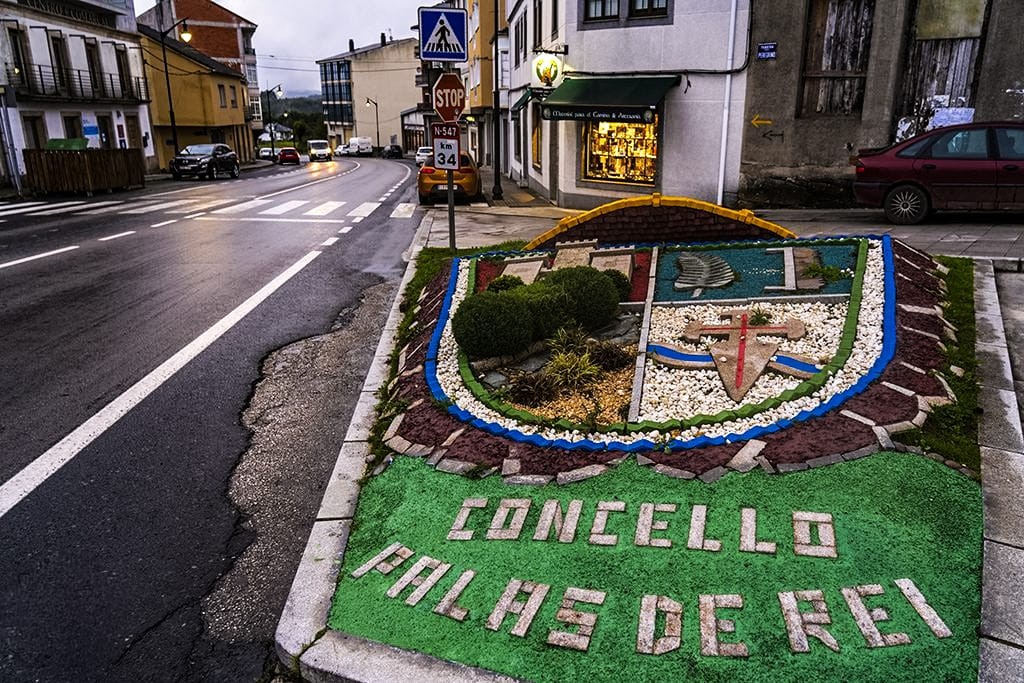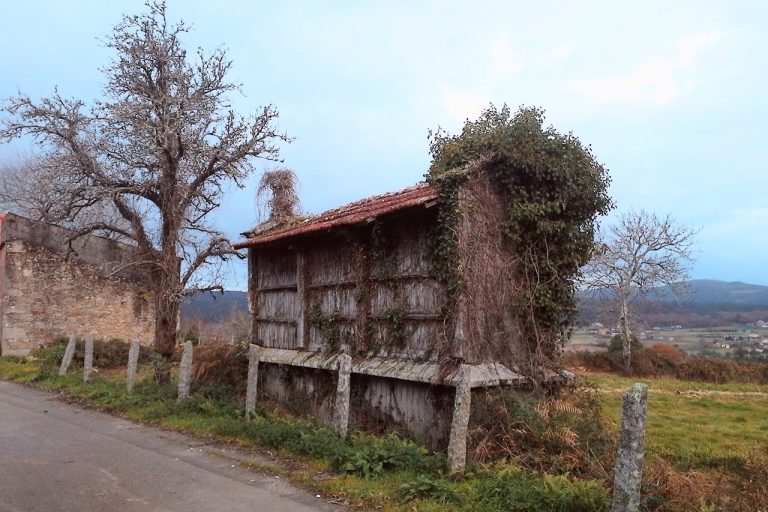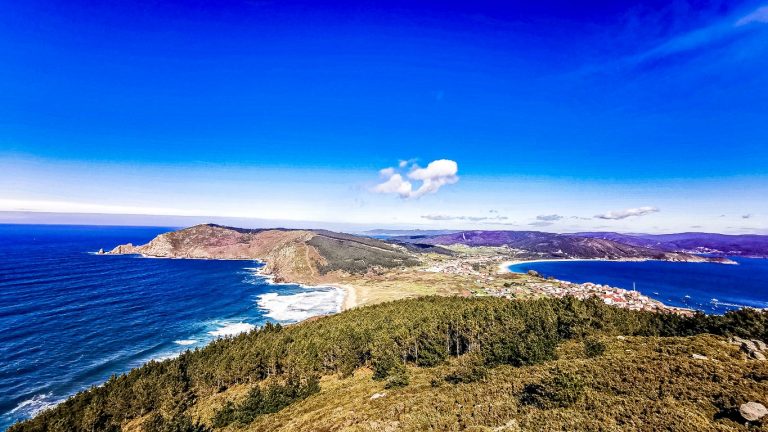
A New Stage Day – Beginning & Atmosphere
The Río Miño still lies under a delicate veil of morning mist as you leave Portomarín. The streets are silent, the stones beneath your feet still damp from the night. You step out through the gate of the Church of San Nicolás, past the Chapel of Our Lady of the Snows – carrying with you a quiet plea, a new day on the Way.
Ahead lies a stage less defined by wild nature and more by the quietness of Galicia – along country roads, through villages, past ancient crosses, through silence and history. The route to Palas de Rei may at times appear paved and unremarkable – yet in its silence something else unfolds: continuity, depth, and the power of perseverance.
Route & Elevation Profile
- Distance: 25.7 km
- Elevation gain: approx. +490 m / –440 m
- Difficulty: Moderate to easy
- Profile: many gentle ascents and descents, with some longer climbs (e.g. San Antonio), mostly paved or well-maintained paths
This stage challenges not with altitude but with monotony. The proximity to the road demands attention – not from your feet, but from your mind. It is a stage of pausing, of walking inwardly.










Variants & Small Detours
The route is straightforward – the only real alternative is a detour to Vilar de Donas. There you will find a Romanesque church with fascinating frescoes and the tombs of the Knights of Santiago. For those interested in art, spirituality, and history, this little loop should not be missed.
Description of the Way – With All Senses
Your day begins with the climb up Monte San Antonio – an early test, before your body is fully awake. You pass a disused brick factory, its abandoned walls telling of past days. The path runs close to the road, flanked by bushes and occasional oaks, a rough ribbon between nature and civilization.
In Toxibó stands a solitary hórreo – a stone-and-wood granary, like a monument to agriculture of the past. The ground here is clay, often muddy in rain. Soon, however, you reach Gonzar, where the first coffee of the day sharpens your senses. The Church of Santa María silently watches over those passing by.
The ascent to Castromaior is short but noticeable. Here you find not only an ancient church but also the remains of one of Galicia’s most important Celtic castros – a fortified settlement from pre-Roman times. The place still pulses within the earth, as if you were not the first to leave your traces here.
In Hospital de la Cruz, the very name of the medieval pilgrim hospital still lingers in the air. Nothing of it remains, yet history lies like fine dust upon the stones.
Ventas de Narón surprises with a chapel whose carved door carries Camino symbols: chalice, scallop shell, cross. The way continues across the plateau of Ligonde – the roof of this stage. Up here the waters divide, flowing either toward the Miño or the Ulla, and you sense the nearness of the Atlantic.
Os Lameiros awaits with a wayside cross of rare beauty: a double-sided stone cross, with the crucified Christ on one side, the sorrowful Mother Mary on the other. At its base: skull, nails, ladder – a plastic, almost baroque faith carved in stone.
Ligonde, once a stop for Charles V and Philip II, shows its former significance in blazoned houses and an old pilgrim cemetery. You feel that many walked here before you – and many did not go further.
The route continues through Airexe, Portos, and Lestedo, past the viewpoint of the Alto do Rosario – from here, on clear days, you can glimpse for the first time the fabled Monte do Gozo and the distant Pico Sacro, heralds of Santiago.
Through Rosario, named after the prayer of pilgrims, the final stretch leads over crunching gravel. Soon Palas de Rei appears – the “City of the King,” once said to have been the residence of a Visigothic monarch.
Intermediate Villages & Special Features
| Village | Distance from Start | Feature | Tip |
| Toxibó | 4.8 km | Traditional hórreo | Morning photo spot |
| Gonzar | 8.3 km | Church of Santa María, first bar stop | Coffee & refill water |
| Castromaior | 9.7 km | Celtic castro & Romanesque church | Archaeological highlight |
| Hospital de la Cruz | 12 km | Historic hospital site | Shady rest spot |
| Ventas de Narón | 14 km | Chapel with carved door, medieval “Sala Regina” | Worth a visit |
| Os Lameiros | 17.5 km | Double-sided cross with symbolic iconography | Photo & moment of reflection |
| Ligonde | 18.5 km | Blazoned houses, pilgrim cemetery, royal history | Short visit to the Church of Santiago |
| Airexe | 19.2 km | Church with Romanesque origins | Refill water |
| Portos | 21.2 km | Detour to Vilar de Donas (Templar church) | Optional ~1 km loop |
| Lestedo | 21.8 km | Casa Rectoral, former hospital and rectory | Spiritual place |
| Rosario | 23.8 km | Traditional place of prayer | Scenic viewpoint in good weather |
| Palas de Rei | 25.7 km | Church of San Tirso with Romanesque portal, royal past | Explore historic town center |
Packing & Shopping Tips
- Food: Gonzar, Ventas de Narón, Ligonde, and Lestedo have bars and small shops. Still, bring provisions.
- Water: Regular opportunities, but carry a spare bottle.
- Gear: In rain, walking poles are useful – sections near Toxibó and Castromaior quickly get slippery.
- Special tip: Don’t forget a sunhat – many stretches offer little shade.
Food, Lodging & Services
- Portomarín: Wide choice of albergues (e.g. Ferramenteiro, Casa do Marabillas, Folgueira) and hotels/guesthouses of all price ranges. Ideal for a calm start.
- Intermediate villages: Gonzar, Hospital de la Cruz, Ventas de Narón, Ligonde, Airexe, and Lestedo all offer simple pilgrim albergues, often private or family-run.
- Palas de Rei: A pilgrim hotspot with over a dozen albergues (e.g. Os Chacotes, Castro, Outeiro, Zendoira) and many guesthouses. Highlights:
- Albergue Zendoira: modern, friendly, very well-rated.
- Complejo La Cabaña: charming complex with restaurant.
- Hotel Casa Benilde: small, charming town hotel.
Today’s Highlights
- Castromaior – a hill full of history. Here lies a pre-Roman castro, still almost mystically watching over the landscape. As a pilgrim you walk upon the same earth trodden more than 2,000 years ago – by traders, soldiers, guardians of the light. The aura is palpable, the ground beneath your feet seems to breathe differently.
- Os Lameiros impresses with a cross that is more than stone. It tells the Passion of Christ in an iconography whose intensity reaches deeper than many museums. Switching from side to side – Crucified, Mother of Sorrows, symbols of suffering – feels like a prayer carved in stone.
- Ligonde, with its royal past, reminds you that the Camino was once not only the path of the faithful but also of the mighty. Emperors and kings, pilgrims and poets – they all walked this road.
Reflection at Day’s End
Today you walked over asphalt and gravel, through mist and sun, past brick factories and pilgrim cemeteries. The way was less picturesque – yet so rich in stories that it carried you further inward. What lingers more in your memory: the silence of the roadside – or the whisper of past pilgrims in Ligonde?
📊 Tabular Overview
| Stage | Start | End | Distance | Elevation Gain/Loss | Difficulty | Key Villages |
| 30 | Portomarín | Palas de Rei | 25.7 km | +490 m / –440 m | Moderate-easy | Gonzar, Castromaior, Ligonde, Airexe, Lestedo |
🌌 Camino of the Stars – Stage 30
Portomarín → Toxibó → Gonzar → Castromaior → Hospital de la Cruz → Ventas de Narón → Os Lameiros → Ligonde → Airexe → Portos → Lestedo → Rosario → Palas de Rei
Did you pause in Castromaior or pray at the cross of Os Lameiros? Share your experiences – your memories are part of the greater whole.


